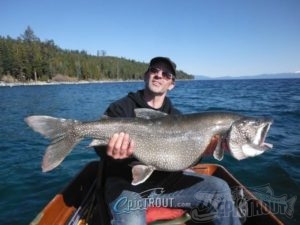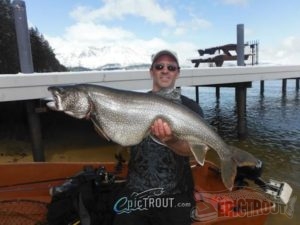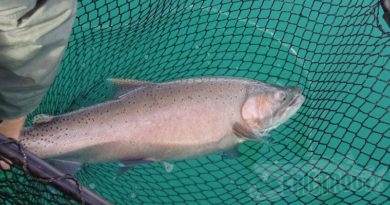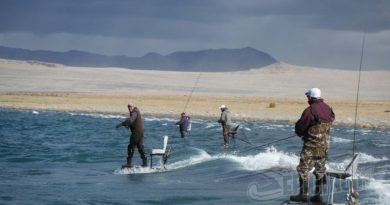Fishing With a Legend Part II
In my last report for Epic Trout I wrote about fishing with legendary angler Allan Cole, inventor of the AC Plug. I have also been fishing with another legend lately, baseball great Ted Williams, ‘The Splendid Splinter’. Sure he died in 2002, but his spirit lives on in my 1973 Ted Williams edition, twelve foot, fiberglass Sears Gamefisher.
I found this little gem on craigslist, and I bought it from a guy in a warehouse, near the whorehouse in Moundhouse, outside Carson City. For two hundred dollars cash I had found my new ultralight fishing boat.

Outfitted with a Nissan five-horsepower motor and a Lowrance portable fishfinder, The Ted has been a fish-catching machine! On its first test run I spread my recently departed mother’s ashes on Tahoe. Though mom was not an angler, I think she would approve of her final resting place, and though I’m not much one for superstition I like to think mom is helping my luck out there. Ted Williams was an avid fisherman, even hosting a fishing show on television after retiring from baseball. So I’ve got that going for me too! Okay, maybe I am superstitious; because I also view my beloved Lake Tahoe as something of a living entity, and I believe she rewards my hard work and bravery (or foolhardiness) for fishing her vast, dangerous expanse in tiny vessels.
Yes, that’s my thing, fishing Tahoe in tiny boats. Started many years ago with a canoe and electric trolling motor. The stealth factor of a quiet motor and a low-profile vessel gave me an edge I’m sure, and I caught so many good fish on the big lake and other area waters that I started documenting my adventures on a popular west coast fishing website. This caused so many readers to write me for advice or ask me to take them fishing that I became a licensed guide in 2001. I worked out of Tahoe Fly Fishing Outfitters initially and did fly trips, spin trips and trolling from my canoe. By popular demand I also began guiding clients on their own boats, showing guys in $50,000 Duckworths tricks I learned on my $300 Coleman. I found guiding fun and rewarding, but a tough living for a guy with a wife and kids, so I kept my regular job. As I saw my friends with nice trailered boats fishing in wind and waves that would kill me in the canoe though, I began to think about upgrading. But though I loved my wife dearly, she was a credit card addict who couldn’t keep a job and the fancy boat was always just out of reach financially.
So in 2004 I expanded my horizons without breaking the bank, purchasing a Porta-Bote and my first gas motor. The manufacturer gave me an outdoor writer’s deal on this lightweight, folding boat, and I later served as a field-tester for them, trying out their latest models and giving the company owner feedback. What I found was that this boat fit the needs of a hardcore trout angler very well. The twelve foot model weighs around 100 pounds, and when disassembled the hull is only about four inches thick and straps easily to a vehicle roof rack while the seats and transom are stored inside your car or truck. The hull shape is a hybrid between a v-hull and a tri-hull configuration, and is very buoyant and stable in rough seas. The hull is flexible plastic, which can take some getting used to as it flexes and moves underfoot, which feels as one friend described it ‘like walking on a waterbed’. Scrape this hull over a shallow submerged rock though, and you will actually feel the rock sliding under your foot without damaging the boat.
So what happened? Why am I fishing out of the Ted Williams? Well although the Porta-Bote is definitely a versatile, well-manufactured vessel, it has one drawback specific to the fishing I do in the Lake Tahoe area. The flexible plastic hull material becomes much stiffer in cold temperatures. I found out early on that this makes the boat more difficult to unfold and assemble quickly, a barrier I addressed by keeping mine assembled most of the time and just putting it on my roof rack upside down like any other cartop boat.
In extreme cold though (close to zero or below zero Fahrenheit), I found that the plastic hull material can actually crack, which is a much more serious issue, possibly leading to catastrophic failure. Most people don’t fish from boats in these temperatures though, since in most regions where the mercury drops this low the lakes freeze over and anglers switch to drilling holes through ice to wet a line. Lake Tahoe is too big and deep to freeze in winter though, so here we have the unique opportunity of trolling for trophy trout while dressed for the Iditarod. How unique? Porta-Bote has sold 100,000 of these vessels over several decades and I am the only user to ever report the cracking problem. I still highly recommend this versatile boat for most applications, but for my midwinter jaunts on the big lake I needed something impervious to the cold.
So after the most recent cracking incident last year, it was time to try something else. Of course now that I’m divorced I could have finally bought a trailered boat (much more affordable than having a wife, it turns out), but over the years I have grown to truly love fishing from cartop vessels. And with a fiberglass boat rather than heavier aluminum, I can load and unload by mysef, and carry to the water’s edge where there are no boat ramps. Plus it’s a kick hearing guys ask “and you caught that huge fish in that thing?”


My inaugural season on The Ted started in midwinter with big Tahoe rainbow trout, up to seven pounds, biting on west shore. These ‘bows were favoring Rapala Countdown plugs and surprisingly were hitting in glass-calm water when we usually require a light chop here to get the plug bite going. Mixed in were brown trout averaging two pounds and two to four pound mackinaw to keep things interesting. As winter turned to spring I tried east shore as well and trolled up a few larger brown trout and mackinaw for myself and a couple of friends. These fish hit on Rebel s and AC Plugs, and again we found a pretty good bite in very calm conditions. The small shadow thrown over the fish by a twelve-foot boat certainly helped, as did trolling the lures 300 to 500 feet back. In addition I often employ sideplaners to get the lure away from the noise and disturbance of my boat and I typically present shallow lures on eight-pound Seaguar fluorocarbon line, which has the diameter of six-pound monofilament. Over the years I’ve had plenty of anglers pump me for one big secret to shallow water success on Tahoe, and the secret I will share here is that there ain’t one! It’s fine tuning all the little details, presenting your lures with precision, and trying new things that add up over time to consistent shallow water action here. Learning a number of different fishing spots on this twelve by twenty-two mile lake helps a lot as well; the bite can be dead in one area but red hot just a few miles away on any given day.

It also helps to be lucky! The really big story this spring is the trophy mackinaw I have found willing to bite on the sandy south shore drops. On March 22 I was fishing with my friend Jeff Turner and we had just started trolling Lyman Lures on lead core line. We were in fifty feet of water, over a flat, featureless bottom, not even to the edge of the underwater shelf where I planned to prospect for lake trout, when Jeff’s rod slowly bent over and the drag began clicking slowly as well. “Looks like you hooked a stick or something.” I told him. He grabbed the rod and told me he felt a slight pump, like he had a small fish on. I slowed my trolling speed and asked him if he wanted me to reel in the other line and put the boat in neutral. “Nah” he replied; “It’s coming in pretty easy.”
My large net was out of my reach in the bow of the boat and I asked Jeff if he could reach it while dealing with his fish. Instead he just handed me the rod: “You just take it and I’ll get the net. I don’t feel like reeling in another mile of lead core just to get a three-pound mack.”
So I took a turn, and as I reeled I felt more and more resistance, then increasingly powerful tugs and head shakes. As I got down to the 100 foot leader of 12-pound Seaguar Fluorocarbon, the fish went into a power-dive, pulling the first three colors of lead core back out. “This is not a three pounder!” I exclaimed as I engaged in a tug of war, working the fish up, and then losing all the line I had gained as it pulled the rod tip down to the water, peeling drag and hurtling back toward the bottom. “It’s over ten. You want it back?”
Jeff thought about it while I had a little more fun, then said “What the hell, yeah let me fight it.” So I handed him back the rod as he handed me the net, then I put the motor in neutral and cleared the other line. My friend had his hands full with this fish for another few minutes before I was able to net it, and it was great that we literally were able to share the experience. Thirty-seven inches long and fairly girthy, ‘our’ mackinaw weighed just under twenty pounds. It was Jeff’s personal best lake trout, and though I helped we don’t go by International Game Fish Association record rules where the catch is disqualified if another angler assists. So I wanted to get a photo of Jeff and his big catch, but he refused. That’s right, my fishing buddy for many years, who was always fine with taking pictures of our catches, has been frequenting an Internet chat board devoted to backpacking and backcountry trout fishing lately, where self -appointed arbiters of fishing morals and etiquette have decided that ‘hero shots’ where an angler poses with his catch, are unseemly. As an outdoor writer and reader of fishing stories though, I know that a smiling angler in the photo adds interest as well as scale to the fish picture, so I had him take the photo of me holding the fish instead, and I reveled in my Glory Poser Hero Shot.
Not quite a Tahoe twenty, but a hell of a fish and mackinaw in the twenty-pound class are hard to come by here. Even the charter captains who are out every day can go many months without seeing one this big. We were fortunate.

And the Ted Williams is a damn lucky boat! On April 26, I was trolling the same area when I hooked and netted a twenty-one pounder! This fish fought hard from the start, eventually coming to the surface 30 feet out and just slowly flapping its huge fins and tail so that I couldn’t pull it an inch toward me. I had to back off the drag and rod pressure so it would dive again, then I was able to winch it back up, close enough to net.
So here I am, a man in his forties, with a beat-up, Rustoleum colored antique strapped to the roof of his car. And let me tell you this rig is NOT a chick magnet, at least if you like a girl with a full set of teeth. But I don’t think I’ll change a thing. Me, a huge trout and Ted Williams posing together makes for one hell of a hero shot!




